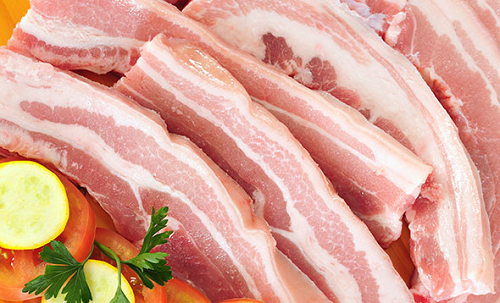When boiling pork, don’t just add water and salt. You should add another ingredient to make the meat more tender and flavorful. Many people think that boiling pork is a simple process, just put the meat in boiling water and wait until it’s cooked. However, to ensure that the boiled pork is delicious, you need to prepare carefully by choosing the right type of meat.

Among the types of pork, pork belly is usually the best choice for boiling. If you have a different preference, such as trotters, pig’s head or shoulder, it’s also fine, depending on your family’s taste. The most important thing is to choose pieces of meat with a tight structure between the lean meat and fat. This helps the sliced meat look more beautiful and enjoyable.
Fresh meat always has its own distinguishing characteristics. They have dry lean parts, slightly firm and regular muscles. The color of fresh meat is usually from pale pink to deep red, and the fat layer should be white or slightly ivory. If you press your finger lightly on the meat and see that the meat sinks and then returns to its original state when you remove your finger, that is a sign of good fresh meat.
In the process of preparing pork, to have tender boiled meat, you need to follow the steps below:
– Choosing the meat: After cleaning the meat, do not cut it into small pieces before boiling. Keep the meat whole to retain its sweetness and flavor. Choose the appropriate type of pork, pork belly is usually the best choice.
– Choosing fresh meat: Fresh meat has its own distinguishing characteristics. They have dry lean parts, slightly firm and regular muscles, and the color ranges from pale pink to deep red. The fat layer should be white or slightly ivory. The important thing is when you press your finger lightly on the meat and see that the meat sinks and then returns to its original state when you remove your finger, that is a sign of good fresh meat.
– Prepare the boiling water: To have delicious boiled meat, pour enough water to submerge the meat in boiling water. If the water is not enough, the meat may turn black and look unappealing.
– Add seasoning: Crush 1 onion or ginger and pour it into the boiling water along with 1 teaspoon of salt.
– Manage the heat: To ensure even cooking inside the meat, use medium heat. Start with low heat, and use a spoon to skim off the foam regularly. This helps keep the broth clear, and the meat becomes clean and odorless.
– Boiling time: The boiling time depends on the size of the meat, usually from 15 to 25 minutes. To ensure that the meat is not dry, check the meat after about 10 minutes by pressing a chopstick into the meat. If the meat oozes pink juice, continue cooking for another 5 minutes. If the meat is cooked, the chopstick will easily penetrate the meat.
– Remove foam: During the boiling process, always skim off the foam to keep the broth clear. This helps make the meat more flavorful and attractive.
– Cool the meat: When the meat is cooked, you can soak it in ice water and wait for it to cool completely. Or you can put the meat in the refrigerator’s cooling compartment for about 10 minutes. This helps the meat retain its bright white and pink color, and when you slice it, the meat won’t be brittle.
– Collagen-rich meat: If you boil collagen-rich meat, be careful with the cooking time. If boiled for too long, the meat may become dry and rough. Collagen-rich meat is usually cooked until it is slightly tender, and should be eaten when it is still.
Maximizing Durability and Energy Efficiency with High-Speed Kettles: Tips and Advice
Are you an electric kettle aficionado? If so, you’ll appreciate Ði?n máy Xanh’s latest offering. We’ve compiled comprehensive instructions to help you make the most of your electric kettle, including tips on how to prolong its life as well as maximize energy savings. Let’s get your kettle expertise up to date!




































